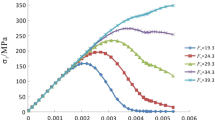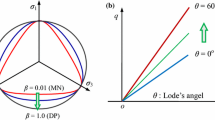Abstract
We present a constitutive model for geomaterials. The unified strength theory, which is modified to be more suitable for the geotechnical engineering, is introduced to reflect the effect of the intermediate principal stress. The polyaxial test data of several rock types verifies that the unified strength theory is versatile. The failure of the micro-elements of material is supposed to be distributed randomly and follows Weibull distribution, and the strengths of elements obey the unified strength theory. A statistical damage variable is proposed. Based on the continuum damage mechanics, a statistical damage constitutive model under the complex stress state is proposed. The proposed model is verified by the tests of soft rock. The result shows that the model can well predict the stress-strain relationship of soft rock, especially the strain softening behavior. The influences of the parameters of the model are investigated.
Similar content being viewed by others
References
C. S. Desai and J. Toth, Disturbed state constitutive modeling based on stress-strain and nondestructive behavior, Int. J. solids Struct., 33 (11) (2006) 1619–1650.
C. S. Desai, Mechanics of materials and interfaces: the disturbed state concept, CRC Press (2001).
Z. J. Shen, An elasto-plastic damage model for cemented clay, Chinese Journal of Geotechnical Engineering, 15 (3) (1995) 21–28 (in Chinese).
Z. J. Shen. A masonry model for structured clays, Rock and Soil Mechanics, 21 (1) (1998) 1–4 (in Chinese).
L Chen, J. F. Shao, Q. Z. Zhu and G. Duveau, Induced anisotropic damage and plasticity in initially anisotropic sedimentary rocks, Int. J. Rock. Mech. Min. Sci., 51 (2012) 13–23.
N. Xie, Q. Z. Zhu, J. F. Shao and L. H. Xu, Micromechanical analysis of damage in saturated quasi brittle materials, Int. J. Solids. Struct., 49 (6) (2012) 919–928.
W. G. Cao, Z. L. Fang and X. J. Tang, A study of statistical constitutive model for soft and damage rocks, Chinese Journal of Rock Mechanics and Engineering, 17 (6) (1998) 628–633 (in Chinese).
X. H. Luo and S. W. Bai, Model analysis on statistical damage of strength of cemented soil, Chinese Journal of Geotechnical Engineering, 26 (5) (2004) 712–714 (in Chinese).
Z. L. Wang, Y. C. Li and J. G. Wang, A damage-softening statistical constitutive model considering rock residual strength, Comput. Geosci., 33 (2007) 1–9.
J. Deng and D. Gu, On a statistical damage constitutive model for rock materials, Comput. Geosci., 37 (2011) 122–128.
H. Z. Li, H. J. Liao and Q. Sheng, Study on statistical damage constitutive model of soft rock based on unified strength theory, Chinese Journal of Rock Mechanics and Engineering, 25 (7) (2006) 1331–1336 (in Chinese).
S. A. F. Murrell, A criterion for brittle fracture of rocks and concrete under triaxial stress, and the effect of pore pressure on the criterion, In: Fairhurst C, editor, Proceedings of the 5th Symposium on Rock Mechanics, University of Minnesota, Minneapolis, MN (1963) 563–577.
J. M. P. Hojem and N. G. W Cook. The design and construction of a triaxial and polyaxial cell for testing rock specimens, South African Mech. Engr., 18 (1968) 57–61.
K. Mogi, Experimental rock mechanics, Taylor and Francis (2007).
P. V. Lade, Rock strength criteria: The theories and the evidence, Comprehensive Rock Engineering (Edited by Hudson, J. A.), Pergamon, Oxford, 1 (1993) 255–284.
B. Haimson and C. Chang, A new true triaxial cell for testing mechanical properties of rock, Int. J. Rock Mech. Min. Sci., 37 (2000) 285–296.
C. Chang and B. Haimson, True triaxial strength and deformability of the German Continental deep drilling program (KTB) deep hole amphibolites, J. Geophys. Res., 105 (2000) 18999–19013.
P. Michelis, Polyaxial yielding of granular rock, J. Eng. Mech., 111 (8) (1985) 1049–1066.
M. H. Yu and L. N. He. A new model and theory on yield and failure of materials under the complex stress state, In: Jono M, Inoue T, editors, Mechanical behaviour of materials-VI, (ICM-6), Oxford: Pergamon (1991) 841–846.
M. H. Yu, Advances in strength theories for materials under complex stress state in the 20th century, Appl. Mech. Rev. 55(3) (2002) 169–218.
M. H. Yu, Y. W. Zan, J. Zhao and M. Yoshimine, A Unified Strength criterion for rock material, Int. J. Rock Mech. Min. Sci., 39 (2002) 975–989.
J. Lemaitre, Course of damage mechanics, Springer, Berlin (1992).
W. Weibull, A statistical distribution function of wide applicability, J. Appl. Mech., 18 (1951) 293–297.
H. X. Zhao, H. Sun and K. W. Lo, Damage soil mechanics, Tongji University Press, Shanghai (2002).
Author information
Authors and Affiliations
Corresponding author
Additional information
This paper was presented at the FEOFS 2013, Jeju, Korea, June 9–13, 2013. Recommended by Guest Editor Jung-Il Song
Hangzhou Li received his B.S. degree from China University of Mining and Technology, M.S. degree from Xi’an University of Science and Technology, and Ph.D. from Xi’an Jiaotong University, China. He is a lecturer in of Civil Engineering at the Xi’an Jiaotong University, China. His current research interests include constitutive model of geomaterials and stability of geotechnical engineering.
Rights and permissions
About this article
Cite this article
Li, H., Liao, H., Xiong, G. et al. A three-dimensional statistical damage constitutive model for geomaterials. J Mech Sci Technol 29, 71–77 (2015). https://doi.org/10.1007/s12206-014-1211-2
Received:
Revised:
Accepted:
Published:
Issue Date:
DOI: https://doi.org/10.1007/s12206-014-1211-2




